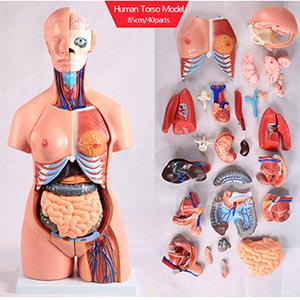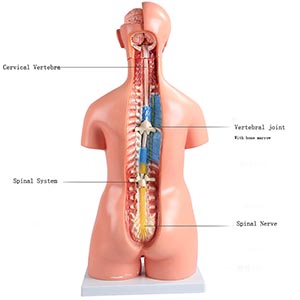With the continuous development of medical education and clinical practice, the traditional anatomy teaching model has gradually exposed some limitations, especially in the education of gender differences. Traditional models mostly use single-sex torso, usually dominated by male models, which to some extent ignores the differences in anatomical structure and physiological function between men and women. In recent years, the emergence of the gender torso model provides a new perspective to solve this problem. So, can the gender trunk model make up for the limitations of the traditional model and become a new trend in medical education and clinical training?
1. Limitations of traditional models

Amphoteric Trunk Anatomical Model
Traditional models of anatomy, especially as applied in medical education, tend to focus on male anatomy. This is mainly due to the bias of historical anatomical research and the higher prevalence of male specimens in practice. However, with the rise of gender medicine, more and more research has shown that there are significant differences in male and female anatomy. For example, women have a wider pelvic structure, and physical functions such as the size of the heart and blood circulation are different. These differences have an important impact on clinical diagnosis, treatment and even surgical operations.
Therefore, the limitation of the traditional model showing only male anatomy is that it does not adequately reflect gender differences, which in turn affects the ability of students and clinical staff to treat patients of different genders.
2. Advantages of the gender trunk model

A gender torso model, as the name suggests, is a torso model that shows both male and female anatomy. Through this model, students can not only see the anatomy of the male torso, but also learn the anatomical features of the female torso. The introduction of this model makes up for the shortcomings of the traditional single-sex model and has the following advantages:
- Sex difference education: The male and female torso models clearly show the differences between men and women in pelvis, chest, muscle distribution, etc. Medical students can understand and learn about the effects of gender on anatomical structure in a more realistic setting, which is essential for subsequent clinical diagnosis and treatment.
- More targeted clinical training: In medical clinical work, the gender difference of patients has an important impact on diagnosis and treatment. With a gender torso model, students are able to practice gender-specific procedures such as chest examinations and abdominal surgeries in a simulated environment.
Enhancing diversity and inclusion: The Gender Trunk model promotes gender equality in medical education, helping students overcome gender bias and develop more inclusive medical thinking.
3. Market trends and data support

With greater awareness of gender differences, market trends in medical education and clinical training are changing. More and more medical schools and hospitals are adopting the gender torso model to enhance students' gender sensitivity and comprehensive anatomical understanding.
According to market research, the global medical education products market is expected to grow at an average annual rate of 5.5%. Especially in Europe and the United States, the rise of gender medicine has led to a sharp increase in the demand for related training models. According to statistics, the medical education institutions using the gender trunk model have improved the performance of students in anatomy and clinical skills training by about 20% compared with the institutions using the single gender model, especially in the diagnosis and treatment links involving gender differences, the students' correct rate has been significantly improved.
4. Conclusion
The gender trunk model can make up for the limitations of traditional model, and it provides a more comprehensive and scientific learning platform for medical education. By reflecting the differences in anatomy and physiology between men and women, students can better understand and apply these differences, and more accurately treat patients of different genders in actual clinical practice. With the market's emphasis on gender sensitivity and diversity, it is expected that the gender trunk model will be more widely used in medical education and clinical training, and become an important tool for medical education in the future.
